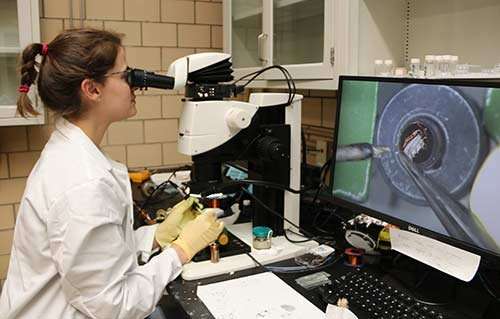Under pressure: a new experimental apparatus gathers more insight on magnetic and superconducting states

It is commonplace to be under pressure at the U.S. Department of Energy's Ames Laboratory— that is, if you happen to be a sample of material undergoing investigation by the lab's condensed matter physicists.
The physicists use the application of high pressure, sometimes nearing as high as that found 1000 miles under the surface of the Earth, to push and prod metallic and semiconducting compounds into revealing unusual structural, magnetic, and superconducting properties that might otherwise remain hidden.
Until now, researchers at Ames Laboratory were able to study magnetization and resistance under pressure, but not a material's specific heat, because of the difficulties presented by both locally heating and pressurizing the sample at the same time. But specific heat, a fundamental material property, under high pressure was too valuable of a measurement to ignore, said Paul Canfield, Ames Laboratory physicist and Distinguished Professor and the Robert Allen Wright Professor of Physics and Astronomy at Iowa State University.
Traditionally, the specific heat of a material is measured in isolation, with nothing touching the sample; but applying pressure requires contact with the sample. With those two conflicting requirements, Ames Lab postdoctoral researcher Elena Gati searched for another way to approach the problem.
The solution was testing and adapting a thermometer typically used in low-pressure experiments for use in high pressure environments, combined with an oscillation technique that delivers pulses of heat that are calibrated to promptly affect the sample but not affect the surrounding environment as quickly.
The scientists have published a number of papers using the technique, which has in each case revealed new properties in the studied materials. It opens up new avenues of research for Ames Laboratory, but also collaborations with other research institutions that could benefit from measurements using the apparatus.
"In all of these cases, we're using this technique to create a map of the electronic, magnetic, and structural phase transitions— how they interact and merge, how they are born and die," said Canfield. "With these kinds of insights, we can infer the rules for how these transitions interact, with the ultimate goal of being able to control them for the properties we want."
The experimental technique and its findings are further discussed in these papers:
"Use of Cernox thermometers in AC specific heat measurements under pressure," authored by Elena Gati, Gil Drachuck, Li Xiang, Lin-Lin Wang, Sergey L. Bud'ko, and Paul C. Canfield; and published in Review of Scientific Instruments.
"Bulk superconductivity and role of fluctuations in the iron-based superconductor FeSe at high pressure," authored by Elena Gati, Anna E. Böhmer, Sergey L. Bud'ko, and Paul C. Canfield; and published in Physical Review Letters.
"Multiple ferromagnetic transitions and structural distortion in the van der Waals ferromagnet VI3 at ambient and finite pressures," authored by Elena Gati, Yuji Inagaki, Tai Kong, Robert J. Cava, Yuji Furukawa, Paul C. Canfield, and Sergey L. Bud'ko; and published as an Editor's suggestion in Physical Review B.
More information: Elena Gati et al. Use of Cernox thermometers in AC specific heat measurements under pressure, Review of Scientific Instruments (2019). DOI: 10.1063/1.5084730
Elena Gati et al. Bulk Superconductivity and Role of Fluctuations in the Iron-Based Superconductor FeSe at High Pressures, Physical Review Letters (2019). DOI: 10.1103/PhysRevLett.123.167002
Elena Gati et al. Multiple ferromagnetic transitions and structural distortion in the van der Waals ferromagnet VI3 at ambient and finite pressures, Physical Review B (2019). DOI: 10.1103/PhysRevB.100.094408
Journal information: Physical Review Letters , Review of Scientific Instruments , Physical Review B
Provided by Ames Laboratory





















